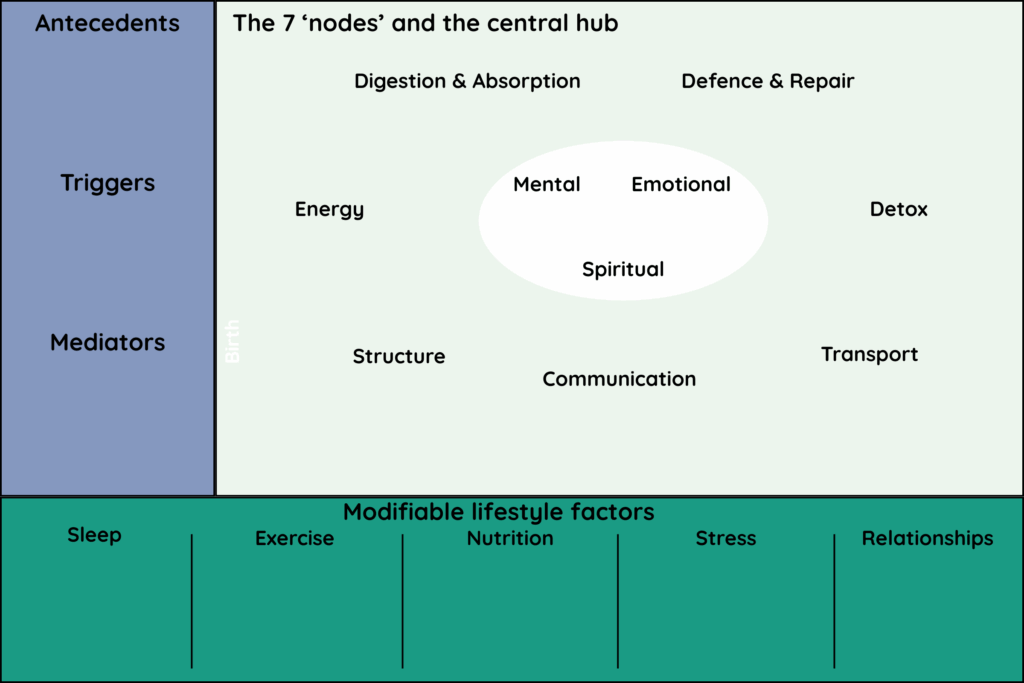Symptoms everywhere and don’t know where to start?
Keep calm and use the Functional Medicine Matrix to map patterns and decide where to focus.
Where this fits
In this series I’m turning core concepts I learnt from the AFMCP course into plain English with one small activity you can try each week to help stop just surviving and start thriving. You’ve seen why exposome beats genome. You mapped your story with the Timeline, and in Sunday Reset #2 I shared how, for me, one trigger (gluten) drove signs across several systems, and how getting the basics right changed everything. That’s the point of the Matrix: see the pattern, then choose a starting point for improving your health.

What the Matrix is
In functional medicine we use two core maps. The Timeline provides a holistic view of your health journey from before birth to present day. The Matrix shows where and how those events and habits are exhibited in your body’s seven interconnected systems. Around the edge sit your ATMs (Antecedents, Triggers, Mediators), read more about these in last week’s post here. Along the bottom are the modifiable lifestyle factors (sleep, movement, nutrition, stress, relationships). In the centre are the mental, emotional and spiritual domains, because mood, meaning and stress tone underpin and interact with every other system.
Why it matters
- Tames complexity. Pulls together complex health stories and turns them into a map you can follow.
- Stops symptom-chasing. You see imbalances in systems, not just labels.
- Reveals patterns. Links life events and routines to today’s symptoms.
- Sets priorities. Points to the one system to work on first.
- Creates a shared plan. You and your clinician can see the same map.
What it’s used for
- Triage: choose the first safe, high-yield changes (one remove, one add).
- Targeted testing (if needed): decide if tests add value and which ones.
- Care coordination: align nutrition, sleep, movement and stress work around the same system.
- Tracking: revisit the Matrix as symptoms shift and update the plan.
Think of the Matrix as the practical bridge from your story (Timeline) to your next step (personalised wellness plan). It shows where you have the greatest imbalances, so you can act on causes and measure what improves.
Why this approach works
Functional medicine treats the body as interconnected systems, not isolated parts. A single cause can create imbalances in multiple systems and a single imbalance can have many causes. The matrix gives you a map which allows you to plot imbalances and from there trace them back to their root causes.
The seven systems
Next I’m going to walk you through the 7 core systems or ‘nodes’ on the matrix. For each one I’ll explain what it is, why it is important and give you 5 questions you can use to do a quick check to see if you might have an imbalance.
1) Digestion & absorption
This is the front door to your health. It’s where you break food down, absorb what you need, and host a microbiome that helps run the place. When this system is steady, meals sit well, bowels are regular, and energy is even. When there is an imbalance here it can have devastating effects which impact every part of your health.
Why it’s so important:
- Fuel for every cell. If you don’t breakdown and absorb protein, fats, vitamins and minerals properly, you can feel tired, weak, foggy or flat, even with a “good” diet.
- Immune training ground. A massive 70-80% of your immune cells live along the gut wall. A balanced microbiome helps keep inflammation calm; a disrupted one can set a fire burning.
- Barrier and clean-up crew. A healthy gut lining lets nutrients in and keeps irritants out. When it’s irritated, you can see a huge range of symptoms like bloating, skin flares, joint aches, or brain fog.
- Mood and nerves. The gut talks to the brain all day via nerves and chemical messengers. Upset the gut and mood, sleep and focus often suffer.
- Blood sugar rhythm. How you digest, and when you eat, can cause energy swings and cravings.
What pushes it off course? Ultra-processed food, low fibre, rushed eating, high alcohol, long stress loads, poor sleep, past infections, antibiotics, and some common medicines.
So if you’re seeing bloating, reflux, irregular stools, food reactions, or knock-on changes in mood, immunity or energy, start here. Fixing this system often steadies several others at the same time.
Quick check (Yes/No):
- Do you get bloating or frequent gas, especially after meals?
- Do you have bowel issues like constipation, or urgency and loose stools?
- Do you get reflux or heartburn? Often?
- Do you get abdominal pain frequently?
- Do certain foods reliably trigger symptoms or aches?
2) Defence & repair
Your immune system is your patrol and clean-up crew. Its job is to spot trouble, switch on fast, clear the mess, and switch off cleanly so you can repair. Inflammation is the right tool for short bursts and critical to responding to injury and repairing the body. It’s a problem when it hangs around. It’s a perfect example of where balance is critical, too much or too little immune action can both create problems.
Why it matters:
- Protection. It keeps infections short and minor.
- Repair. It mends tissues after exercise, injury, or everyday wear and tear.
- Tolerance. It learns what to ignore (pollen, foods, your own tissues) and what to fight.
What pushes it off course? Poor sleep, high stress, ultra-processed food, low omega-3s and phytonutrients (helpful chemicals from plants), low vitamin D, a disrupted microbiome, smoking, high alcohol, pollutants, gum disease, and lingering infections. These inputs nudge the system towards a constant low-grade “on” state.
How imbalance shows up: frequent colds that drag on, wounds that heal slowly, skin flares (eczema, rashes, hives), congested sinuses, allergies, or aching/swollen joints—often worse after poor sleep, a stressful week, or certain foods. You may also notice morning stiffness, brain fog on “inflammation days”, or flares that track with your gut.
Quick check, do you:
- Catch colds/bugs often or take long to recover?
- Have joints that swell or flare with modest activity?
- Get chronic sinus issues or repeated infections?
- Get Rashes or hives without a clear cause?
- Have gum inflammation or gums that bleed when you brush or floss?
3) Detoxification (biotransformation and elimination) — why this system matters
This is how your body processes and clears things it makes (hormone by-products, cell waste) and things you are exposed to (alcohol, medicines, additives, pollutants). The liver transforms fat-soluble compounds into water-soluble forms. Then you eliminate them through bile and stool, urine, breath and sweat. Regular stools, good hydration, sound sleep and steady movement keep the conveyor belt running. This is not a juice cleanse. It’s quiet, daily house-keeping.
Why it matters:
- Less build-up, less friction. Efficient processing lowers background irritation and oxidative stress.
- Clearer signals. Hormones and immune messengers behave better when waste leaves on time.
- Whole-body effects. Energy, skin, mood and aches often improve when clearance improves.
What pushes it off course? Regular alcohol. Lots of ultra-processed food. Low protein and low veg diversity (especially if you’re missing brassicas and sulphur-rich veg like onions and garlic). Dehydration and constipation. Poor sleep. Long stress loads. Low daily movement. High exposure to fumes, solvents or smoke. Courses of medication can add load too.
How imbalance shows up: heavier hangovers from small amounts of alcohol. Headaches or brain fog after wine or strong smells. Constipation or “sticky” stools. Skin flares or itch that rise with rich meals or alcohol. Feeling sluggish on waking even with enough sleep.
Quick check, do you:
- Find strong smells (perfume, petrol, cleaning products) give you headaches or nausea?
- Feel rough after small amounts of alcohol, especially wine or cocktails?
- Have bowel movements less than once daily or find them hard to pass?
- Do you wake groggy or foggy despite “enough” sleep, especially after heavy meals or drinks?
- Do you get skin flares or itch that seem to worsen after alcohol or rich, processed food?
4) Communication
This is your messaging network. Hormones, neurotransmitters and stress pathways keep time for the whole body. They set appetite and cravings, steadiness of mood, focus, daily rhythms (circadian), thyroid tone and sleep. When signals are clear and well-timed, you feel alert by day, calm at night, and your energy and appetite feel in balance.
Why it matters:
- Timing. It runs your daily alert–calm cycle and sleep–wake rhythm.
- Coordination. It links blood sugar, thyroid, sex hormones and brain chemistry so systems move together.
- Resilience. It helps you mount a stress response, then stand down again.
What pushes it off course? Erratic sleep, late screens and bright light at night, low morning light, irregular meals or lots of refined carbs, low protein, high alcohol, too much or too-late caffeine, long stress loads, inactivity, and chronic inflammation from elsewhere.
How imbalance shows up: tired-and-wired at night, 3–4 am waking, daytime sleepiness, focus dips, low or flat mood, low libido, sugar swings and cravings, temperature sensitivity, and feeling easily derailed by stress. You may also notice cycle changes, brain fog, or a “buzzed” feeling despite exhaustion.
Quick check, do you:
- Feel tired and wired at night or 3–4 am waking?
- Notice your mood or focus shift with stress or poor sleep?
- Have libido lower than expected for your age?
- Use anti-inflammatory drugs, blood-pressure tablets or antidepressants regularly?
- Find life stresses quickly tip you off track?
5) Energy
This is cell output. Tiny power plants in your cells, called mitochondria, turn oxygen and nutrients into usable energy. When output is steady you wake clear, move without tiring quickly, and are able to think straight.
Why it matters:
- Everything costs energy. Thinking, digestion, repair and immune control all draw from the same pot.
- Rhythm and resilience. Good output means steady mornings, fewer 3 pm slumps, and faster recovery after effort.
What pushes it off course? Poor sleep, erratic light exposure, under-eating protein or key micronutrients, big sugar swings and high sugar/carb diets, long stress loads, inactivity or overtraining, chronic inflammation, past infections, alcohol, and some common medicines.
How imbalance shows up: unrefreshed on waking, afternoon crashes, brain fog, heavy limbs or muscle pain after modest effort, reliance on caffeine or sugar, and getting more breathless on stairs than you’d expect.
Quick check, do you?
- Get unexplained fatigue most days?
- Find even after eight hours sleep you are still flat/tired on waking?
- Find moderate effort/exercise leaves you wiped out or sore?
- Have regular 3pm slumps or brain fog?
- Find stairs leave you more breathless than they should?
6) Transport
This is delivery and clearance. Blood and lymph move oxygen, nutrients and hormones to your tissues, then carry waste and fluid away. It also includes blood sugar control so your brain and muscles get a steady fuel supply.
Why it matters:
- Steady energy and mood. Steady flow of blood sugar means fewer crashes and cravings.
- Healthy tissues. Good circulation feeds your heart, muscles, joints and brain.
- Fluid balance. Lymph keeps swelling down and supports immune function.
What pushes it off course? Long sitting and low daily movement. Lots of refined carbs and low fibre. Dehydration. Smoking or high alcohol. Poor sleep and long stress loads. Low iron or B12. Heat and standing all day.
How imbalance shows up: sugar swings with shakiness or irritability. Cold hands and feet. Light-headed on standing. Ankle swelling by evening. Brain fog after meals. Labs trending the wrong way for lipids or glucose.
Quick check, do you:
- Have high blood pressure, cholesterol or glucose?
- Get shaky or irritable between meals or big hunger swings?
- Have a family history of heart disease, circulatory problems or recent labs that worry your clinician?
- Get cold hands/feet or light-headed on standing?
- Have any concerns about the health of your heart or blood vessels?
7) Structure
This is your frame and scaffolding: muscles, joints, fascia, posture and bone. When it’s working, force moves cleanly through the body, you feel stable, and everyday tasks cost less effort.
Why it matters:
- Load and movement. Good alignment and tissue quality spread load so joints don’t take a beating.
- Circulation help. Contracting muscles act as pumps for blood and lymph, which supports recovery.
- Confidence and capacity. Strength and balance make stairs, lifting and longer walks feel doable.
What pushes it off course? Long desk hours, poor workstation setup, old injuries that never fully settled, low daily movement, weak glutes/core, sudden “weekend warrior” bursts, stress-related muscle tension, low protein or key minerals, unsupportive footwear and sleep positions that crank the neck/shoulders.
Quick check:
- Morning stiffness that eases as you move?
- Recurrent injuries in the same area?
- Headaches tied to work setup or sleep position?
- Weakness or instability with daily tasks?
- Do short strength sessions ease pain or improve control?
8) your centre (mental, Emotional and spiritual)
This is your control room: cognition, attention, mood, stress response, meaning and purpose. It sets the tone for every other system. When this hub is steady, hormones pulse on time, immunity is calmer, the gut moves smoothly, pain signals are quieter, and sleep cycles run properly.
Why it matters:
- Body-wide effects. The brain talks to hormones, the immune system and the gut all day. A calmer centre means fewer flares elsewhere.
- Stress precision. A healthy response lets you gear up for challenges and stand down afterwards. That “off switch” protects sleep, digestion and joint comfort.
- Motivation and follow-through. Mood and meaning drive the habits that heal (food, movement, sleep).
What pushes it off course?
- Sleep loss and irregular bed/wake times.
- Late light and screens, low morning daylight.
- Unprocessed stress, lack of boundaries, long work hours.
- Isolation or thin social support.
- Ultra-processed food, alcohol, and big caffeine swings.
- Chronic pain or illness feeding back into mood and focus.
How imbalance shows up:
- Sleep issues (hard to switch off, 3–4 am waking, unrested mornings).
- Feeling flat, anxious, irritable or over-amped.
- Brain fog, word-finding issues, poor focus.
- Low resilience: small stresses hit harder; recovery takes longer.
- Body echoes: IBS-type symptoms, tension headaches, neck/shoulder tightness, pain flares on bad sleep weeks.
Quick check, do you:
- Have trouble getting to sleep or staying asleep?
- Feel flat, anxious or over-amped most days?
- Have memory or concentration below your best?
- Think your overall health has declined in the last two years?
- Find everyday stresses feel harder to handle than they used to?
Do this week: map your Timeline onto the Matrix (15 minutes)
1) Print or sketch the Matrix. Use the graphic in this post. Email me if you want a PDF version
2) Bring your Timeline across. Go back to last week’s post if you missed it, once you’ve completed your timeline you can then move your key Antecedents, Triggers and Mediators into the left hand column. You can also list any key lifestyle factors in the relevant sections at the bottom of the matrix. Finally look at your current concerns, and main medical problems and do your best to map these into the right system/node on the Matrix (don’t worry if they cross more than one node this is common, put it where you think it fits best, its fine to list in more than one node as well if relevant).
3) Score each system. For every system above, answer the five questions. Give that system a score from 1 to 5 based on how many Yes answers you gave (one ‘Yes’ = one point). Write the scores under each node.
4) Circle your starting point. Step back and look at your completed matrix, which node or nodes have the highest scores and the most linked current concerns? Restoring balance to this system is likely to be the thing which will provide the biggest impact and benefit to your health.
5) Choose one thing you can remove and one to add: Review my previous post on inputs here, what are the simple changes you can make in your life to remove something which is causing the imbalance in your system(s), and what is your body lacking that it needs? How are you going to make those changes to your life?
Please note functional medicine practitioners train for years to be able use the matrix effectively, so if you are struggling please consider working with a trained professional. This exercise is meant to stimulate some self reflection and be a jumping off point for further research, analysis and action to improve your health, and to make this easier by highlighting where you may want to focus your time and attention.
Need support? Use the IFM Find a Practitioner directory.
What’s next
Over the coming weeks we’ll deep-dive each system and look at simple changes to correct imbalances and create the conditions for your body to thrive.
Subscribe here to the Sunday Reset to get one of these articles and activities each week.
Want the back-story of why I work this way? Read Sunday Reset #2: From ‘Surviving’ to ‘Thriving’ — my experience of functional medicine. It shows how one trigger created symptoms across systems, and how simple, consistent changes turned it around.
Disclaimer
This article is designed to be education, not medical advice. Speak to your clinician before making any significant changes, especially if you take medication or have a diagnosed condition.


